News
ICI Publishes Sectoral Report on Leather and Leather Goods Production
- 08.04.2015
- News
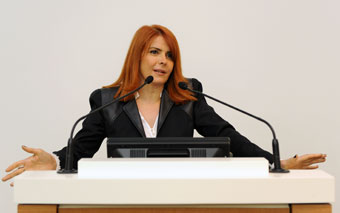
According to the “Sectoral Report on Leather and Leather Goods Production” published by the Istanbul Chamber of Industry (ICI), between 2005 and 2013 the leather exports of Türkiye increased two-fold to reach USD 1.9 billion with added value growing by the same rate to TL 1.63 billion.
The Istanbul Chamber of Industry (ICI) released the “Sectoral Report on Leather and Leather Goods Production”, prepared with the contribution of sectoral committees and NGOs in the leather industry. According to the report, production of leather and leather goods production in Türkiye increased by 16.7 percent between 2005 and 2013. Exports and added value in the sector both increased by approximately two-fold to reach USD 1.9 billion and TL 1.63 billion, respectively. The sector contributed to 1.25 of Türkiye’s total exports in 2013.
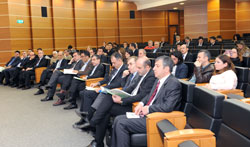
The report highlights export goal of USD 10 billion for the Turkish leader industry to be achieved by 2013, and outlines 19 strategies aimed at enhancing the global competitiveness of the sector, which include: support of husbandry by placing greater emphasis on leather similar to dairy and meat production, removal of the 20% excise duty on the import of raw, semi-finished and finished fur hides, reduction of energy costs and labor burden, decrease of the reference prices for exports to Russia, and implementation of more controls against informal markets.
Paving the way for further research and new policies
ICI’s Sectoral Report on Leather and Leather Goods Production has been announced at a meeting in the presence of sector representatives. Delivering the opening speech of the meeting, Sultan Tepe, ICI Board Member, stated the report’s aim to bolster the cooperative strength of the leather industry and enhance corporate collaboration. “This report will pave the way for further research and new policies in the future,” Sultan Tepe said, adding:
“In this context, it is of great importance to develop policies for strategic sectors with high export potential and an ongoing need for transformation through R&D and high technology.
The Ministry of Science, Industry and Technology has been developing strategy papers on industry and sectoral action plans since 2011; a significant step in terms of our industry, revealing an increasing awareness in this area.
What we hope to see is to see the impact of this increase awareness on all platforms, particularly through university-business collaborations.”
Number of livestock in Türkiye diminishing
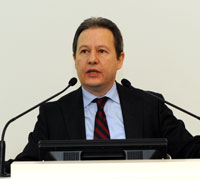
İSO Danışmanı
Can Fuat Gürlesel
Dr. Can Fuat Gürlesel, ICI Counselor, noted that the sector had so far failed to deliver solutions to long-standing problems, despite its significant potential. “The current incentives do not target the areas where the industry is heavily organized, and it is not practical to relocate the manufacturers in these areas either. The incentives must be expanded to cover these areas to support this labor-intensive industry,” Gürlesel said.
The presentation of the report was followed by a panel moderated by Dr. Can Fuat Gürlesel. The panel addressed the ongoing need to support husbandry by placing greater emphasis on leather similar to dairy and meat production, and reduce energy costs and labor burden of businesses.
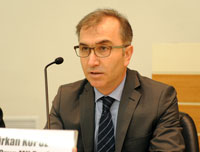
İSO 12. Grup Deri ve
Deri Mamulleri Sanayi
Meslek Komitesi Başkanı
Gürkan Kopuz
Taking floor in the panel, Gürkan Kopuz, Chairman of the ICI’s 12th Sectoral Committee of Leather and Leather Goods, pointed out that the leader industry depended on livestock for raw material, and that the number of livestock was diminishing, saying: “Unfortunately, due to cost and meat concerns, female animals are butchered before breeding. Without breeding, the numbers will not increase. We need the government to implement appropriate controls in this regard. We take the rawhide coming from the butchering process and turn it into a raw material to be used in shoemaking and leathercraft. We are like the wagons on a train. Efforts aimed at developing the shoemaking industry would also benefit the leather industry as well. I believe that the additional financial obligations implemented in the shoemaking industry should be withdrawn. Our country is not particularly focused on animal husbandry, and we should not have to feel the pressure of importing. We are facing difficulty overcoming competitive challenges brought about by costs, and it falls to the public authorities to deliver a solution.”
Brands like H&M and Zara have scaled up shoe purchases
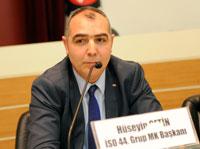
İSO 44. Grup Ayakkabı ve
Yan Sanayi Meslek Komitesi
Başkanı Hüseyin Çetin
Hüseyin Çetin, Chairman of the ICI’s 44th Sectoral Committee of Shoes and Side Industry, noted that the footwear industry had an export goal of USD 2.5 billion by 2023, and accounted for 55 percent of the sector’s total, saying, “The footwear group, which is one of the subsectors, recorded an increase in exports despite tensions in Russia, Ukraine and Iraq. World’s leading ready-made clothing brands, such as H&M and Zara have scaled up their footwear purchases from local producers. In terms of production capacity, we rank first in Europe ahead of Italy; however, we cannot transfer this potential into value added products. I believe we will utilize this capacity in the future. I do also believe that we will see a further growth in exports, as we started to make ourselves heard successfully in international fairs.”
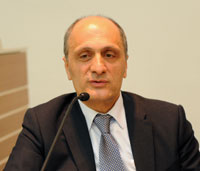
İstanbul Deri ve Deri Mamulleri
İhracatçıları Birliği Yönetim
Kurulu Başkanı Mustafa Şenocak
Mustafa Şenocak, Chairman of Istanbul Leather and Leather Goods Exporters Association, pointed out that leather was one of the only three sectors that saw an increase in export volume in March, adding, “We have achieved a significant leap in export volume of semi-finished goods, thanks to international fairs in Far East, China in particular. Our exports to Russia, the largest market in the world, diminished somewhat, but we did record a 10 percent increase in exports to Italy, the runner-up. We have significant shortcomings when it comes to promoting Turkish leather. We need to maintain our position in our existing markets while moving into new ones. Moreover, it is essential for us to conform to the trends in fashion and design, which would help further increase our exports.”
Leather industry not as appreciated as meat
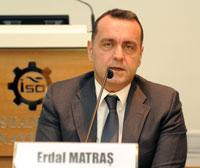
Türkiye Deri Sanayicileri Derneği
Yönetim Kurulu Başkanı
Erdal Matraş
Erdal Matral, Chairman of the Turkish Leather Industrialists’ Association, remarked on the importance of husbandry, which provides the raw material for the leather industry, saying, “Meat product consumption in Türkiye exceeds 100 million tons, but the emphasis placed on the meat industry is not reflected in leather. Türkiye consumes red meat, so the leather industry should be able to fulfill its raw material needs from its source. 30 of every 100 animals in Türkiye are of the highest quality. Leather industry is present in 14 organized industrial zones (OIZs) and 20 provinces across Türkiye. However, there are provinces without their own slaughterhouses. Other countries have begun to surpass Türkiye in leather industry. For instance, India has banned the export of rawhide, and now only exports bags, footwear; in other words, value added products. We, on the other hand, export rawhide for a fraction of the income, and no added value.”
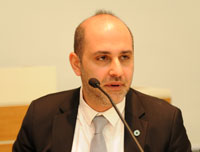
Ayakkabı Yan Sanayicileri Derneği
Yönetim Kurulu Başkanı
Tan Erdoğdu
Tan Erdoğdu, Chairman of the Turkish Footwear Components Manufacturers’ Association, noted that the shoe was more than a simple sole and piece of leather as it seemed at first glance, saying, “We have a tough job. We receive outputs from 40 different industries. We conducted a research on market diversification. Despite the decrease in exports, Russia remains our top market. We visited Ethiopia for a fair, which actually resulted in six of our companies starting export to the country. We have a dynamic sector, but there is a certain lack in capital. We must focus our efforts, specifically on R&D and innovation.”
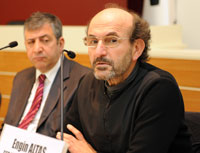
Saraciye Sanayicileri Derneği
Yönetim Kurulu Üyesi
Engin Altaş
Engin Altaş, Board Member of the Leathercraft Industrialists’ Association remarked on the importance of leveraging experience and know-how in creating brand value. “Without a brand, there is no sense in manufacturing value-added products. We need to craft our products with diligence to add value and develop our brand value. We should not expect the government to hold our hands throughout the way. We must find the fault in our own efforts. One cannot simply open a retail store and call itself a brand; it takes a chain, sale to overseas, and advertisements. It must start on a micro scale and take on a continuous form,” Altaş said.

Türkiye Deri Konfeksiyoncuları
Derneği Yönetim Kurulu Başkanı
Yakup Teleke
Finally, Yakup Teleke, Turkish Leather Ready-made Manufacturers’ Association Chairman, took floor to deliver a short speech, which delved on the burden of excise duties and possible solutions faced by companies operating in foreign markets. “Traditionally, Russia has been an important market for ready-made leather clothing. The leather fairs organized in Istanbul serve as a window for the sector. I also agree on the importance of producing value-added products, and delivering new investment incentives.”
Russia: Turkish largest export market
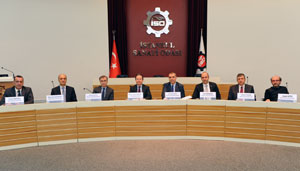
According to the report, as of 2013, Türkiye accounts for 0.79 percent of the world’s leather market, and the 10th country by export volume. Fur industry achieved the largest share among subsectors, with 7.7 percent. The report named Russia as the largest export market of Türkiye with USD 508 million, followed by Italy with USD 131 million and Germany with USD 114 million. China topped the chart as the leading exporter of leather, followed by Italy, Hong Kong, France and Germany; whereas USA emerged as the leading importer of leather by far, with USD 30 billion.
Fur garment and leathercraft production in decline
The report highlighted a 7.9 percent decrease in productivity in the leather industry, measured by per capita output, between 2005 and 2013. Shoemaking increased by 32.9 percent and tanning by 2.3 percent, whereas leather garment production went down by 21.3 percent, mainly due to the decrease in fur garment and leathercraft production. Basic economic indicators for leather and leather goods production in 2012 were recorded as follows: 71,076 employees, TL 8.56 billion in total production value, 1.15 percent share in total production, 2.2 percent share in total employment, 1.12 percent share in added value. According to the report, shoemaking recorded the largest share in production value and added value among subsectors of leather and leather goods production, with approximately 50 percent. The report also highlighted an increase in new brands in the sector, with the number of registered brands up from 716 in 2000 to 1,919 in 2013.
19 strategic goals set for leather
The report outlined the following 19 strategic goals for Turkish leather and leather goods industry:
- Increased support for husbandry by placing greater emphasis on leather similar to dairy and meat production,
- Removal of the 20% excise duty on the import of raw, semi-finished and finished fur hides, and reduction of the 18 percent VAT to 8 percent.
- Reduction of the Resource Utilization Support Fund (RUSF) rate to 1 percent for imports on credit, and 0 percent for goods not locally manufactured,
- Development of the accessories sub-industry,
- Reduction of energy costs and labor burden of businesses,
- Implementation of the Sixth Group incentives to organized industrial zones operating in leather production,
- Support of environmental investments and costs via Ministry of Environment and Urbanization’s budget,
- Granting OIZ status to concentrations of industries developed outside OIZs,
- Increased contribution from the leather industry to the Turquality and Brand Support Program,
- An export volume of USD 10 billion by 2023,
- Including private exports into the formal export process, with associated excise duty returns to manufacturers and exporters,
- Reduction of reference prices and transit fees for exports to Russia,
- Increase of foreign exchange usage limits within the Inward Processing Regime to 75 percent,
- Increased customer awareness about the difference between natural and faux leather,
- Training quality human resources while maintaining craftsmanship,
- Reviewing regulations on labor to reduce additional burden,
- Resolving of issues brought about by different VAT rates in leathercraft (18 percent in purchases, 8 percent in sales),
- Increased quality assurance on imported products, and more controls on discounts,
- Implementation of more controls against informal markets and for better intellectual property rights.